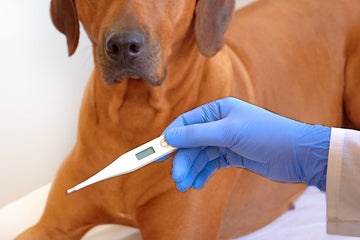8 Min Read
What Is A Normal Temperature For Dogs?
Key takeaway

Why pet owners are switching to online vet care with Dutch
-
Prescriptions delivered free to you
-
Fast access to Licensed Vets over video
-
Unlimited video visits and follow-ups
A normal dog's temperature is typically much different from yours. When you pet your dog, you may think they have a fever because they feel much warmer. So what's a normal temperature for dogs? Typically, dogs have an average temperature of 101 Fº. If you believe your dog is unwell, you can take their temperature at home to determine whether it's time to see your vet.
Knowing your dog's temperature can help you monitor them when they are sick. Remember, a fever is your dog's way of fighting off illnesses. However, if your dog's temperature gets too hot or cold, it could indicate a serious medical emergency.
That said, what should your dog's temperature be, and how can you take your dog's temperature at home to determine if they're sick? Keep reading to find out.
Normal Dog Temperature vs. Fever
Typically, a dog's normal temperature hovers around 101 Fº. However, the average temperature range falls between 99.5 Fº to 102.5 Fº. 1 Anything higher or lower than this signals a serious medical emergency. A fever — a temperature above 103 Fº — can indicate infection, inflammation, disease, and even cancer in dogs.2
The dog's brain helps regulate their body temperature, acting as a thermostat to maintain a consistent temperature when they're healthy. However, it can also influence heat production, including heat loss and gain.2 For example, several factors can impact a dog's body temperature, including hypothermia, illness, heat stroke, and more.
Even a single degree above or below the normal temperature range could indicate illness. Most dogs have a normal temperature between 100.2 Fº and 102.5 Fº.3
However, a dog's normal temperature ranges depending on their activities. For example, a dog lying in the sun may have a slightly warmer internal temperature. This doesn’t mean that they have a fever. Because there's such a wide range, it's usually best to take your dog's temperature when they're healthy to determine their average. Some dogs may run naturally warmer than others, so what's considered a fever in one dog isn't in another.
Signs of a Fever: How to Tell if Your Dog Has a Fever
High body temperatures, also known as fevers, include any temperature above 103 Fº.3 Unfortunately, your dog can't tell you when they have a fever, so it's often one of the most inconspicuous signs associated with illness. That said, if your dog has a fever, it's highly likely they're experiencing other signs, such as:
- Lethargy
- Warm ears
- Shivering
- Loss of appetite
- Behavioral changes
- Dehydration
- GI issues3
Unfortunately, there are several causes of fevers in dogs, so you won't know why your dog has a fever until you take them to the vet for examination. For example, a fever may indicate an ear infection, upper respiratory infection, or urinary tract infection (UTI).3 It can also be a sign that your dog has ingested poison. How to Take Your Dog’s Temperature?
Taking your dog's temperature at home can help you determine if they're running a normal dog temperature or suffering from a fever, which could be a matter of life and death. Unfortunately, many pet parents think they can accurately assess their dog's temperature by touching their noses or ears. However, touching your dog anywhere on their body cannot give you an accurate measurement of their internal temperature, so it's always best to use either a rectal or ear thermometer.
We recommend a rectal thermometer because it's the most accurate.
Here's how to tell if your dog has a fever or hypothermia:
- Grab your supplies: Apart from the rectal thermometer, you need a fragrance-free, water-soluble lubricant (such as Vaseline), towel, and plenty of treats. We also recommend having a helper with you to hold your dog while you insert the thermometer.
- Add lubricant: When you're ready to begin, coat the tip of the thermometer with the lubricant.
- Prepare your dog: Your dog will likely try to resist the thermometer, so you should hold them snugly with an arm under their belly to gently press them against your body. If you have a helper, they can hold the dog for you.
- Insert the thermometer: Once your dog is calm, you can lift their tail and insert the thermometer about an inch into the rectum. Be careful not to push too far or too forcefully, both of which can cause discomfort or injury. Keep the thermometer steady and in place, until it beeps or the recommended time has passed.
- Read the results: If you're using a digital thermometer, it will beep when it's done. However, if you're using a glass thermometer, you'll need to wait until the time is up before reading and removing it.
- Wash your hands and treat your dog: After the process is complete, wash your hands and reward your dog.
Is My Dog’s Temperature Normal: When to See a Vet
In addition to your dog's temperature, you should consider their other signs. Sometimes dogs can get sick without a temperature change, so you should look for other signs of illness, such as:
- Lethargy
- Lack of appetite
- Change in behavior
- Loss of consciousness
Remember, any temperature above 103 Fº requires vet intervention. Once your dog is at the vet's office, they'll try to diagnose the cause of the temperature change, which may include blood, urine, and other types of testing.
Once your vet diagnoses what is causing your dog’s fever or illness, they'll create a treatment plan, which will vary depending on what's making your dog sick. For example, if your dog has an ear infection, your vet will send you home with medicated ear drops to treat the underlying cause and eliminate the signs.
While you may know the normal temperature for dogs, it can be difficult for pet parents to get an accurate reading when taking their dogs’ temperatures themselves. If you believe your dog is unwell for any reason, it’s always a good idea to consult a vet, whether or not they’re showing signs of a fever.
FAQs
What if my dog’s temperature is low?
Low body temperatures are any that drop below the normal dog temperature. There are several levels of hypothermia — mild, moderate, and severe — which can tell you when it's time to take your dog to the vet. However, all types of hypothermia can be dangerous, especially if your dog's body temperature drops below 99Fº.4
If your dog's temperature drops too low, they may experience physical signs of hypothermia, such as:
- Shivering
- Increased heart rate
- Rapid breathing
- Dilated pupils
- Loss of consciousness
If your dog is conscious and you believe they may have mild hypothermia, the best thing you can do is wrap them in a warm blanket and place a hot water bottle wrapped in a towel next to them before contacting your vet for the next steps.4 However, if your dog's body temperature dips below 97F, it's usually best to consult a vet immediately because they either have moderate or severe hypothermia, which can result in death.4
How can you check a dog’s temperature without a thermometer?
There is no accurate way to check your dog's temperature without a thermometer. While some pet parents believe they can tell if their dog has a fever by feeling their nose or ears, these methods are unreliable myths. The only way to know if your dog has a normal temperature is to use a proper thermometer.
However, as a responsible pet parent, you should watch for these signs that your dog isn't feeling well, regardless of whether you suspect a fever:
- Changes in energy level or unusual lethargy
- Loss of appetite or refusal to drink water
- Changes in behavior (becoming withdrawn or unusually aggressive)
- Vomiting or diarrhea
- Coughing or difficulty breathing
- Unusual whining or crying
- Changes in posture (hunched back, lowered head)
- Red or swollen gums
- Excessive drooling
- Limping or reluctance to move
If you notice any of these signs, don't wait to get a temperature reading before contacting your vet. These signs alone warrant veterinary attention, as they could indicate various health issues that require professional care.
How to tell if a dog has a fever with a human thermometer?
While you can use a regular digital human thermometer to check your dog's temperature rectally, there are several important considerations to keep in mind. Standard digital thermometers can work effectively, but they must be thoroughly cleaned and disinfected before and after use. Once you've used a human thermometer on your dog, it should be permanently labeled "FOR PETS ONLY" and never used on humans again. Always ensure you're using proper lubrication and a gentle technique to avoid causing your pet any discomfort.
However, not all human thermometers are suitable for dogs. Never use glass mercury thermometers due to the risk of breakage, and avoid oral thermometers designed for human mouths. Forehead scanner thermometers won't work effectively on dogs due to their fur, and human ear thermometers aren't suitable because dog ear canals are shaped differently than human ones.
Your best option is to purchase a thermometer specifically designed for pets or invest in a pet ear thermometer for easier temperature taking. Consider keeping a dedicated pet thermometer in your dog's first aid kit. Remember, when in doubt about your dog's temperature or health, it's always best to consult with your veterinarian rather than trying to diagnose at home.
Final Notes
Knowing the normal temperature for dogs can help you determine if your dog is under the weather and when to take them to the vet. A fever may indicate a serious underlying issue, like a contagious virus that can affect other pets in your household, while a drop in temperature may signal life-threatening hypothermia.
Every dog is different, and their daily activities may impact their body temperature. For example, your dog's body temperature will change when they're more active. A fever is a sign, and it's usually associated with other signs. Conversely, hypothermia is a serious illness that requires immediate medical attention.
Don't wait to get your dog the care they need when they're sick. Worried about your dog's temperature? We can help diagnose and treat a variety of underlying causes of fevers in dogs and advise you on what to do when your pet's temperature changes. Plus, members get free shipping from our online pet store, so you can get the supplies you need to care for your pet’s health delivered right to your door. Try Dutch today.
Share
References
-
Fielder, Susan E. "Normal Rectal Temperature Ranges - Special Subjects." Merck Veterinary Manual, 31 Jan. 2023, https://www.merckvetmanual.com/special-subjects/reference-guides/normal-rectal-temperature-ranges.
-
Allen, Andrew J. "Fever of Unknown Origin in Dogs - Dog Owners." Merck Veterinary Manual, 31 Jan. 2023, https://www.merckvetmanual.com/dog-owners/metabolic-disorders-of-dogs/fever-of-unknown-origin-in-dogs.
-
"Fever in Dogs: Causes, Signs, and Treatment." American Kennel Club, 26 Dec. 2021, https://www.akc.org/expert-advice/health/dog-fever-and-temperature/.
-
"Hypothermia in Dogs: How Cold Is Too Cold?" American Kennel Club, 31 Jan. 2023, https://www.akc.org/expert-advice/health/hypothermia-in-dogs-how-cold-is-too-cold/.



